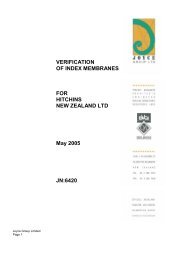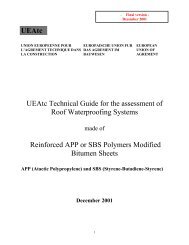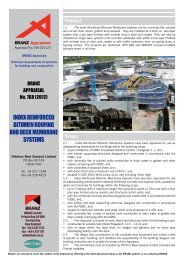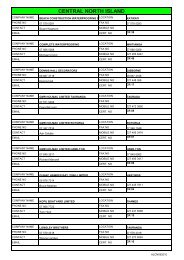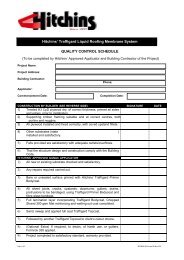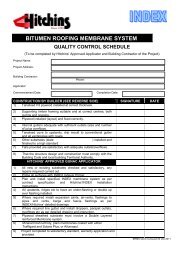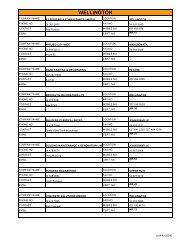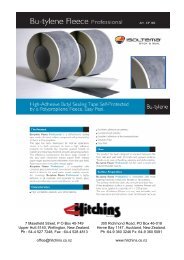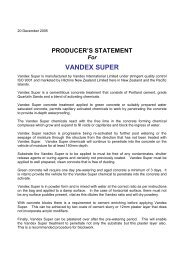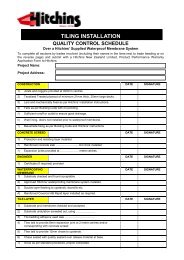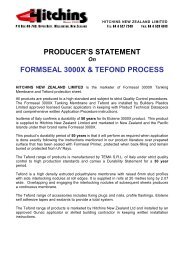TECHNICAL DOSSIER PROTEADUO TRIARMATO 4 mm ... - Hitchins
TECHNICAL DOSSIER PROTEADUO TRIARMATO 4 mm ... - Hitchins
TECHNICAL DOSSIER PROTEADUO TRIARMATO 4 mm ... - Hitchins
Create successful ePaper yourself
Turn your PDF publications into a flip-book with our unique Google optimized e-Paper software.
ROLLBASE<br />
Polymer bitumen membrane reinforced with glass fibre felt and with the lower face finished with a non woven<br />
polyester , the top surface is protected by a PE film. Mass per unit area 2 kg/m², the width of the selvedge is<br />
5 cm and the dimensions of the rolls is 10 by 1.05 m.<br />
3 rd Section<br />
Application’s information<br />
Loose laid application<br />
By “loose laid” we mean application of waterproofing system completely detached from the substrate: this<br />
method cannot be used for slopes higher than 5%, as a heavy protection is always necessary (with gravel or<br />
concrete tiles); moreover, this system is advisable when the membrane is applied on thermal insulating<br />
panels. Perimeters and parapets and vertical walls are always fully bonded by torching. In case of doublelayer<br />
application, the second layer is fully torched to the first one, keeping the first layer staggered 50 cm<br />
from the second one.<br />
Partially-bonded application<br />
When “partially-bonded ” the waterproofing systems must be adhered using a predetermined ratio to give an<br />
even application over the total surface area. On concrete substrates, the surface has to be treated with a<br />
primer and spot-torched afterwards, in order to obtain a bonded surface for 50% of the whole. This way of<br />
application is advised for slopes up to 40%. Perimeters and parapets and vertical walls are always fully<br />
bonded by torching.<br />
Alternatively, we may suggest the use of perforated membrane “Perfobase” for slopes up to 20%; for higher<br />
slopes the use of mechanical fixing at the end of the roll is advised.<br />
In case of non continuous concrete substrates, in between the substrates itself, stripes of at least 20-cm<br />
width have to be mechanically fixed (and/or by torch) to one of the two adjacent elements. Where a doublelayer<br />
system is requested, the second of these layers is fully torched on the first, keeping a staggered of 50-<br />
cm between the membrane of the first and second layer.<br />
On substrates made of thermal insulating panels, a bituminous fibreglass felt weighing 1500 g/m2 has to be<br />
applied as a first layer. This should be spot-bonded using hot oxidised bitumen 85/25 for slopes up to 5%, or<br />
100/30 oxidised bitumen type for slopes between 5 and 15% , in order to obtain a minimum bonded surface<br />
equal to 50% of the whole surface.<br />
Afterwards, the membrane has to be completely torched. Alternatively, we may suggest the use of “Defend<br />
3” or “Helasta V3” for slopes up to 20%, whereas for higher slopes a mechanical fixing of the heads of the<br />
rolls will have to be considered. For application on thermal insulating panels with bitumen treated surface,<br />
the perforated membrane “Perfobase” could be used, by fully torching the waterproofing layer afterwards.<br />
The vertical borders and perimeters are always carried out by fully bonding.<br />
Fully bonded application<br />
By “fully bonded” we mean application where the membrane is fully adherent to the substrate. In case of<br />
discontinuous concrete elements and load-bearing concrete element substrates, please refer to the chapter<br />
above, except for bonding that has to be done on the whole surface.<br />
Similar systems are considered for application on substrates made of thermal insulating panels, stressing<br />
that bonding of bituminous fibreglass felt or of the membrane has to be fully adhered. Alternatively, we may<br />
suggest to using membrane “Defend 3” or “Helasta V 3” fully bonded. This way of application is advised for<br />
slopes up to 40% on concrete substrates and up to 20% for substrates made with thermal insulating panels.<br />
For larger slopes, a mechanical fixing on the head of the rolls will have to be taken into consideration. In<br />
case of double-layer application, the second membrane is fully bonded on the first, ensuring the two layers<br />
are staggered of 50cm. This kind of application must be used next to dumping area, vertical borders and<br />
expansion joints.<br />
Page n° 10 out of 24




